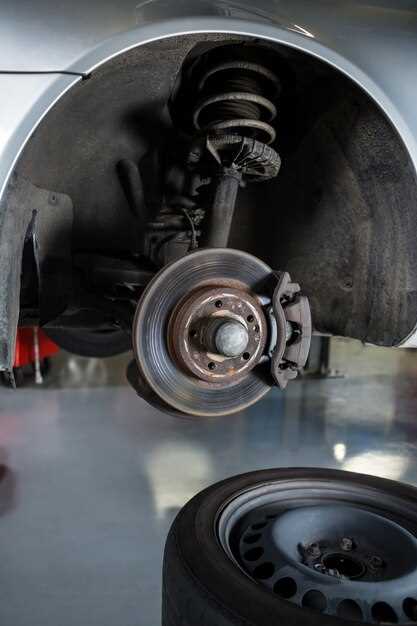How to Prevent Brake Fade on the Track


Brake fade is a critical issue that can severely impact track performance and safety. As drivers push their vehicles to the limit on the racetrack, the brakes undergo immense stress. Continuous braking can lead to overheating, causing a reduction in braking efficiency, which can be dangerous at high speeds. Understanding the mechanics of brake fade is essential for any serious track enthusiast who aims to enhance their lap times while maintaining control.
There are several factors that contribute to brake fade, including the choice of materials, the design of the braking system, and driving techniques. Selecting high-performance brake pads, rotors, and fluids specifically designed to withstand the rigors of track use is crucial. Additionally, proper maintenance and adjustments can prevent brake fade from becoming a liability during crucial moments of a race.
In this article, we will explore effective strategies for preventing brake fade. By examining techniques related to gear shifting, brake management, and the selection of appropriate components, drivers can ensure their braking systems remain effective under the demanding conditions of the race track. Implementing these strategies will not only improve lap times but also enhance overall vehicle stability and driver confidence.
Understanding Brake Fade: Key Factors
Brake fade is a critical phenomenon that affects performance during track driving. It occurs when brakes overheat, leading to a significant reduction in braking efficiency. Understanding the key factors that contribute to brake fade is essential for maintaining optimal track performance.
Several elements influence the onset of brake fade, including material composition, temperature management, and usage patterns.
| Factor | Description |
|---|---|
| Brake Material | Different brake pads and rotors are made from various materials, each with unique thermal properties. High-performance materials can withstand higher temperatures before experiencing fade. |
| Heat Dissipation | Effective cooling systems, including vented rotors and proper airflow, help dissipate heat. Insufficient cooling accelerates fade. |
| Operating Temperature | Brakes operate optimally within a specific temperature range. Exceeding this range can lead to a reduction in friction and increased fade risk. |
| Driving Style | Aggressive driving can lead to excessive braking and higher temperatures. Smooth, calculated braking helps mitigate fade. |
| Track Conditions | Different surfaces and weather conditions impact braking performance. Wet or uneven surfaces can increase the risk of fade. |
Prioritizing these factors allows drivers to minimize brake fade and enhance their overall track performance. Monitoring brake temperature and selecting the right components are crucial steps in this process.
Selecting the Right Brake Pads for Optimal Heat Resistance
Selecting the appropriate brake pads is crucial for maintaining performance under intense track conditions. Brake pads must be able to withstand high temperatures without losing effectiveness, which can lead to brake fade. Materials, friction coefficients, and intended use all play important roles in this selection process.
There are several types of brake pad materials, each with varying levels of heat resistance. Performance-oriented pads typically fall into three categories: organic, semi-metallic, and ceramic. Organic pads provide decent performance for street applications but often lack the heat resistance required for track use. Semi-metallic pads, containing metal fibers, offer better heat dissipation and durability, making them a popular choice for racing. Ceramic pads provide excellent heat resistance and consistent performance but may not always perform well from cold.
Another key parameter to consider is the friction coefficient, which affects how well the pad grips the rotor. High-friction pads usually perform better at elevated temperatures and offer improved stopping power, which is crucial for track driving. However, excessive friction can lead to increased thermal buildup, so balance is required to optimize performance.
In addition to material and friction, understanding the operating temperature range of the brake pads is essential. Race-oriented pads are designed to operate within specific temperature limits. Selecting pads that reach their optimal performance temperature quickly can help prevent fade during prolonged sessions on track. Some manufacturers provide detailed temperature graphs, allowing you to choose pads that match your specific driving style and vehicle setup.
Finally, proper installation and bedding of the brake pads cannot be overlooked. Bedding ensures that the pads and rotors establish an effective transfer layer, enhancing performance and increasing overall heat resistance. Following manufacturer instructions for bedding procedures can dramatically improve braking performance and reduce the risk of fade.
Upgrading Brake Fluid to Mitigate Vapor Lock

Vapor lock occurs when brake fluid reaches its boiling point, causing the formation of vapor bubbles within the braking system. This scenario can lead to a loss of hydraulic pressure, ultimately resulting in brake failure, particularly during intense track sessions. One effective strategy to combat this issue is upgrading the brake fluid used in your vehicle.
Standard brake fluids, such as DOT 3 and DOT 4, have lower boiling points compared to higher-performance alternatives. When subjected to extreme temperatures generated during hard braking, the risks associated with vapor lock increase. Upgrading to a high-temperature brake fluid, such as DOT 5.1 or even racing-specific fluids, significantly enhances the boiling point, thereby reducing the likelihood of vapor formation under hot conditions.
High-performance brake fluids not only offer improved thermal resistance but also possess superior moisture absorption characteristics. Over time, brake fluid can absorb moisture from the atmosphere, which lowers its boiling point and can lead to premature boiling. Using a fluid with a lower hygroscopic rate helps maintain optimal performance and longevity, ensuring a more consistent braking experience on the track.
When considering an upgrade, it is crucial to flush the existing brake fluid from the system completely. Mixing different types of brake fluid can lead to decreased performance and potential system damage. After flushing, fill the system with the chosen high-performance fluid and ensure proper bleeding of the brake lines to eliminate air pockets.
Regular maintenance checks and timely changes of brake fluid are essential factors in preventing vapor lock and optimizing braking performance. By upgrading your brake fluid, you enhance not only safety but also the overall track experience, allowing your vehicle to perform at its best under demanding conditions.
Implementing Proper Cooling Solutions for Brake Systems
Effective cooling solutions are crucial for preventing brake fade during high-performance track driving. Overheating can lead to diminished braking efficiency, compromising safety and performance. Here are several strategies to enhance cooling for brake systems.
First, upgrading to high-performance brake rotors is essential. Vented or slotted rotors improve airflow, promoting better heat dissipation. These designs allow for gas and heat to escape, reducing the likelihood of brake fluid boiling and decreasing overall brake performance.
Incorporating ducting systems can significantly enhance airflow to the brake components. Ducts direct cool air from the vehicle’s front end straight to the brake calipers and rotors. This minimizes thermal buildup, ensuring consistent performance during extended track sessions.
Another effective method is using cooling fins attached to calipers and rotors. These fins increase surface area, allowing for improved heat transfer. Some high-performance calipers are specifically designed with integrated cooling fins for optimal heat management.
It’s also important to consider the use of high-temperature brake pads. These pads are engineered to maintain performance under extreme conditions, reducing the risk of fade. Selecting pads that are not only compatible with your rotors but also designed for track use ensures that they can withstand higher temperatures without deterioration.
Finally, regular maintenance and inspection of the brake system are vital. Ensuring that all components are in good condition, including brake fluid levels, can further support effective cooling. High-performance brake fluids with higher boiling points can also be advantageous, maintaining braking efficacy under duress.
Adjusting Driving Techniques to Reduce Brake Overuse
To minimize brake fade during track performance, drivers can implement various techniques that lower reliance on braking. Here are some effective strategies:
- Anticipate Turns:
Begin planning your deceleration before reaching a turn. Look ahead to identify apex points and adjust your speed accordingly, allowing for smoother entry into corners.
- Threshold Braking:
Understand the concept of threshold braking, which involves applying just enough brake pressure to maximize deceleration without locking the wheels. This technique helps in maintaining vehicle control and reducing brake wear.
- Use of Engine Braking:
Utilize engine braking by downshifting before entering a corner, which allows the engine to assist in slowing the vehicle. This reduces the burden on the braking system while maintaining speed control.
- Brake Modulation:
Practice smooth brake modulation instead of sudden, hard braking. Gradual pressure application not only enhances comfort but also prevents brake overheating.
- Smooth Steering Inputs:
Avoid jerky steering actions when entering or exiting turns. Smooth steering inputs help maintain momentum and reduce the need for additional braking.
- Optimize Racing Line:
Learn to follow the optimal racing line, which can often minimize speed loss in corners and decrease the need for excessive braking. Focus on clipping the apex and exiting at the right angle to maintain speed.
Incorporating these techniques into your driving style will not only preserve brake performance but also enhance overall track efficiency and lap times. Constant practice and focus on these strategies will lead to sustainable driving habits on the track.
Regular Maintenance Practices to Ensure Brake Longevity
Maintaining the braking system is crucial for performance and safety on the track. Regular upkeep reduces the risk of brake fade and enhances overall durability. Here are key practices to ensure brake longevity:
- Routine Inspection:
- Check brake pads for wear and uneven patterns.
- Inspect rotors for scoring, warping, or discoloration.
- Examine brake lines for leaks or deterioration.
- Brake Pad Replacement:
- Replace brake pads when they reach manufacturer-recommended wear limits.
- Use high-performance pads suited for track conditions.
- Consider upgrading to ceramic or metallic pads for better heat resistance.
- Rotor Maintenance:
- Regularly clean rotors to remove debris and brake dust.
- Machine or replace rotors if they show signs of excessive wear.
- Ensure proper bedding-in of new rotors and pads to enhance performance.
- Brake Fluid Management:
- Change brake fluid at recommended intervals to prevent moisture build-up.
- Use high-temperature brake fluid to withstand track conditions.
- Check for air bubbles in the brake lines, which can reduce responsiveness.
- Caliper Care:
- Inspect calipers for binding or corrosion.
- Ensure proper lubrication of caliper pins for smooth operation.
- Replace seals if leaks are detected to maintain hydraulic pressure.
- Temperature Management:
- Monitor brake temperatures using sensors during sessions.
- Use cooling ducts to direct air towards brakes for temperature regulation.
- Choose suitable track tires that compliment brake performance under load.
Implementing these maintenance practices will enhance brake performance and longevity, ensuring that your vehicle remains reliable and responsive on the track.
